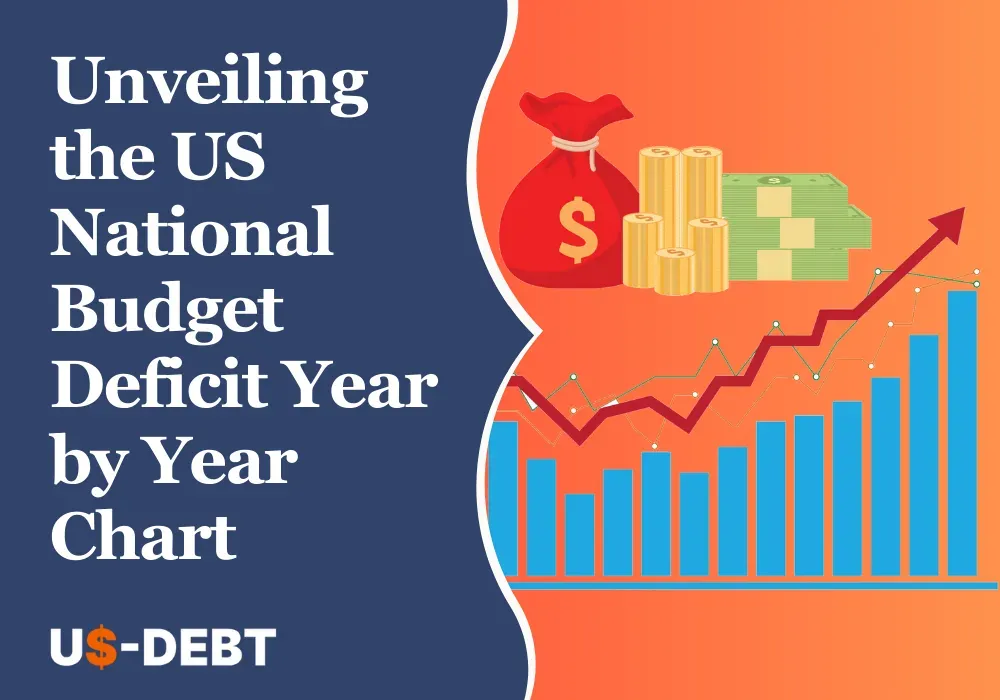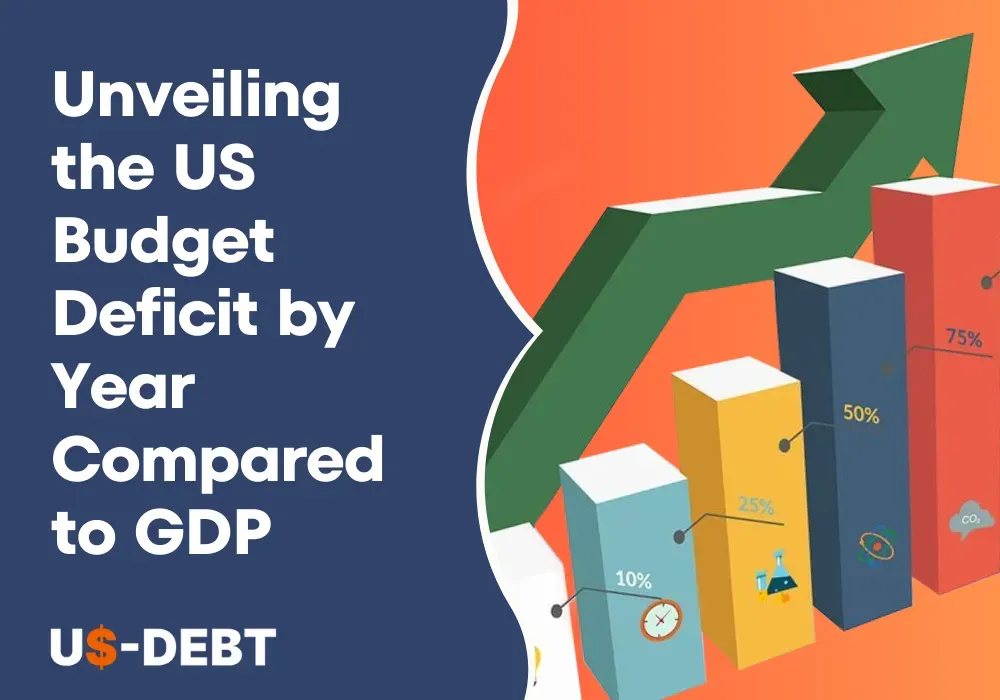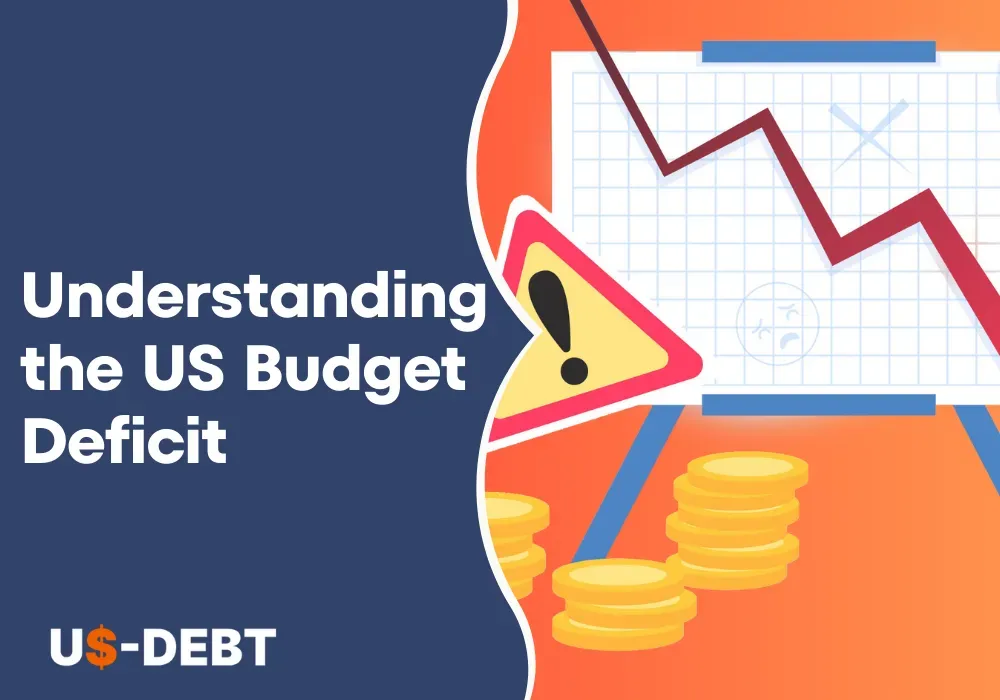The national debt and deficit of the United States are two significant economic factors that frequently draw attention and concern. To fully comprehend their importance, interactions, and effects on the US economy, we shall go further into these themes in this blog post. We seek to provide readers with a thorough grasp of the relationship between the US debt and the national deficit by examining historical patterns, policy choices, and global viewpoints.
Â
Brief Overview of the US Debt and National Deficit
The US debt refers to the total amount of money that the federal government owes to various creditors, including foreign countries, investors, and individuals. This debt accumulates over time due to budget deficits, which occur when the government spends more money than it collects in revenues through taxes and other sources. As a result, the government borrows money to bridge the gap between income and expenditure, leading to an increase in the overall national debt.
On the other hand, the national deficit represents the annual shortfall between government expenditures and revenues. When expenses exceed income in a given fiscal year, the deficit arises, adding to the existing debt burden. Conversely, a budget surplus occurs when revenues exceed expenditures, which helps reduce the national debt.
Â
Importance of Understanding the Relationship between Debt and Deficit
Understanding the relationship between the US debt and the national deficit is of paramount importance for several reasons. Firstly, it enables citizens, especially students, to comprehend the financial stability of their country and how government policies impact the economy. A large and rapidly growing debt with substantial deficits can have repercussions on future generations, affecting their standard of living and opportunities.
Secondly, grasping this concept empowers individuals to make informed decisions as voters and taxpayers. By being aware of the government's financial situation, citizens can hold policymakers accountable and advocate for responsible fiscal policies.
Furthermore, the US debt's magnitude can influence interest rates, inflation, and global economic dynamics. A high debt level may lead to higher interest payments, diverting funds from critical investments in areas like education, infrastructure, and healthcare.
Â
Exploring the US National Debt
Â
Definition and Explanation of the National Debt
The US national debt is a significant economic indicator that represents the total amount of money owed by the federal government to various creditors. It arises from persistent budget deficits, which occur when the government spends more money than it collects in revenues from taxes and other sources. To cover these deficits, the government borrows money by issuing Treasury bonds, bills, and notes, accumulating debt over time.
The national debt serves as a cumulative record of past deficits and surpluses. When the government operates at a surplus, meaning its revenues exceed expenditures, it can pay down some of the debt. However, when deficits persist, the debt continues to grow, impacting the nation's financial health.
Â
Historical Trends and Growth of the National Debt
Throughout US history, the national debt has experienced significant fluctuations and growth. Early in the nation's history, the debt was primarily incurred due to wars, including the Revolutionary War and the War of 1812. After each conflict, efforts were made to reduce the debt through economic growth and fiscal discipline.
In the 20th and 21st centuries, the national debt grew substantially, influenced by events like the Great Depression, World Wars, and economic recessions. The debt reached notable highs during the aftermath of the 2008 financial crisis and the COVID-19 pandemic when the government implemented stimulus packages to support the economy.
Â
Types of Debt Held by the US Government
The US government's debt is held in various forms, including:
Public Debt: This includes debt held by individuals, institutions, foreign governments, and the Federal Reserve. Public debt is subject to interest payments and is traded in financial markets.
Intragovernmental Holdings: This comprises debt the government owes to itself. For instance, government agencies, such as Social Security and Medicare trust funds, hold Treasury securities. These holdings represent money that one part of the government owes to another and also accrue interest.
Foreign Holdings: The US government owes a significant portion of its debt to foreign countries. Nations like China and Japan are among the largest foreign holders of US debt.
Â
Understanding the US National Deficit
Â
Definition and Explanation of the National Deficit
The US national deficit refers to the annual shortfall between the federal government's total expenditures and its revenues, primarily generated from taxes and other income sources. When the government spends more money than it collects in a given fiscal year, a deficit occurs. This deficit is funded through borrowing, which increases the overall national debt.
The deficit arises due to various reasons, including economic downturns, increased government spending on programs and services, and changes in tax policies. While some level of deficit spending can be necessary during certain periods to stimulate the economy or address emergencies, a consistently high deficit can have long-term implications for the nation's financial health.
Â
Historical Trends and Patterns of the National Deficit
Over the years, the US has experienced fluctuations in the national deficit. During times of economic expansion, tax revenues tend to rise, and government spending on safety nets may decrease, resulting in lower deficits or even surpluses. However, during economic recessions or times of crisis, such as wars, the deficit often widens as government spending increases to address challenges and stimulate the economy.
Throughout history, several significant events have influenced the deficit. For instance, during World War II, the government dramatically increased spending to support the war effort, leading to substantial deficits. In the late 1990s and early 2000s, the country witnessed a period of budget surpluses, but this was followed by an increase in deficits during the 2008 financial crisis.
Â
Factors Influencing the National Deficit
Several factors contribute to the fluctuations in the national deficit. Economic conditions play a crucial role, as periods of economic growth generally lead to higher tax revenues and lower expenditures on programs like unemployment benefits. Conversely, economic downturns may necessitate increased government spending on stimulus packages and social support, resulting in larger deficits.
Government policies, especially regarding taxation and spending, also impact the deficit. Tax cuts can reduce revenue streams, potentially leading to higher deficits if spending remains unchanged. Similarly, decisions to increase spending on defense, healthcare, or infrastructure can contribute to a wider deficit.
Interest payments on the national debt also affect the deficit. Higher interest rates can lead to increased spending on servicing the debt, putting further strain on the budget and potentially exacerbating the deficit.
Â
Relationship between US Debt and National Deficit
Â
How does the National Deficit Contribute to the National Debt?
The relationship between the US national debt and the national deficit is interconnected. The national deficit directly contributes to the growth or reduction of the national debt. The national deficit is the annual shortfall between the federal government's total expenditures and its revenues from taxes and other sources. When the government spends more money than it earns, it must bridge the gap by borrowing funds. These borrowings accumulate over time, adding to the overall national debt.
For example, if the government spends $1 trillion in a fiscal year but only collects $800 billion in revenues, it faces a deficit of $200 billion. To cover this deficit, the government will issue Treasury securities, like bonds, to borrow $200 billion from investors and other entities. This borrowing adds to the national debt, as the government now owes an additional $200 billion to its creditors.
Â
Impact of Fiscal Policies on Debt and Deficit
Fiscal policies implemented by the government can significantly influence both the national debt and the national deficit. Fiscal policies refer to the government's decisions regarding taxation and spending to achieve economic goals.
Taxation: Changes in tax policies can impact government revenues. For example, tax cuts can stimulate economic growth but may lead to reduced revenue, potentially widening the deficit. Conversely, tax increases can generate more revenue, which may help reduce the deficit and slow down the growth of the national debt.
Government Spending: Decisions about government spending play a crucial role in shaping the deficit. Increased spending on social programs, infrastructure, or defense can contribute to a larger deficit and, subsequently, a higher national debt. On the other hand, prudent spending or spending cuts can help reduce the deficit and slow down debt accumulation.
Â
Also Read:Â What is the US Military Budget: An In-Depth Look at Defense Spending?
Â
Relationship between Economic Conditions and Debt Accumulation
Economic conditions have a direct impact on both the national debt and the national deficit. During economic downturns or recessions, government revenues tend to decrease as unemployment rises and business activity slows down. In such times, the government may need to increase spending on stimulus packages and safety nets, leading to larger deficits and faster growth in the national debt.
Conversely, during periods of economic growth, tax revenues tend to increase as more people are employed and businesses thrive. This can lead to smaller deficits or even budget surpluses, which allow the government to pay down some of its existing debt.
Â
Public Perception of US Debt and National Deficit
Â
Common Misconceptions about Debt and Deficit
Â
Debt is Always Bad: One common misconception is that all debt is inherently bad. While excessive debt can lead to economic challenges, moderate and strategic borrowing can be necessary to stimulate the economy or invest in critical infrastructure and social programs.
Deficit Equals Wasteful Spending: Some believe that a budget deficit reflects irresponsible government spending. However, deficits can also arise from economic downturns or unexpected emergencies, where increased spending may be necessary to support the economy and assist citizens in times of need.
Â
Political Narratives and Public Discourse
Public perception of the national debt and deficit is often influenced by political narratives and public discourse. Different political parties and interest groups may frame these economic concepts in ways that suit their agendas, leading to biased or oversimplified representations. This can make it challenging for the public to form a well-rounded understanding of the complexities of fiscal matters.
Moreover, during election cycles, the national debt and deficit may become focal points of debate, often with exaggerated claims about the economic consequences of the opposing party's policies. This can create confusion and polarized views among the public.
Â
Educating the Public on Fiscal Matters
To foster a more informed and nuanced understanding of the US debt and deficit, there is a need for increased public education on fiscal matters. Government agencies, educational institutions, and independent organizations can play a crucial role in providing accessible and unbiased information.
Efforts to educate the public should include:
Plain Language Explanations: Using simple language to explain complex economic concepts can make information more understandable and relatable to the general public.
Non-Partisan Resources: Providing non-partisan resources and analysis can help dispel misconceptions and promote balanced viewpoints.
Transparent Reporting: Governments can enhance transparency in reporting fiscal data, making it easier for citizens to access and interpret information about the debt and deficit.
Civic Engagement: Encouraging civic engagement and discussions about fiscal matters can empower citizens to participate in the decision-making process and hold policymakers accountable.
Â
Role of the Federal Reserve to Control of US Debt and National Deficit
Â
Federal Reserve's Influence on Debt and Deficit
The Federal Reserve, as the central banking system of the United States, plays a significant role in controlling the country's debt and national deficit. While the Federal Reserve does not directly determine government spending or taxation policies, it employs various monetary tools to influence economic conditions and indirectly impact debt and deficit levels.
Â
Monetary Policy and Its Relationship with Government Borrowing
The Federal Reserve implements monetary policy to achieve its dual mandate of stable prices and maximum employment. One of the key tools it uses is the setting of interest rates. When the economy is growing too quickly, the Federal Reserve may increase interest rates to curb inflation. On the other hand, during economic downturns, it may lower interest rates to stimulate borrowing, spending, and investment.
Government borrowing is affected by the interest rates set by the Federal Reserve. Lower interest rates make borrowing more affordable for the government, potentially encouraging deficit spending. Conversely, higher interest rates can increase the cost of servicing existing debt and may prompt the government to be more cautious about borrowing.
Â
Balancing Fiscal and Monetary Measures
To control US debt and national deficit effectively, a balance between fiscal and monetary measures is crucial. Fiscal policy, controlled by the government through taxation and spending decisions, directly impacts the deficit. Policymakers need to exercise prudence in managing government expenditures to prevent excessive deficits and debt accumulation.
The Federal Reserve, through its monetary policy decisions, can provide support to the government's fiscal objectives. By adjusting interest rates and implementing other monetary tools, the Federal Reserve can influence economic conditions and create an environment conducive to sustainable economic growth and responsible government borrowing.
Â
Global Perspectives on US Debt and National Deficit
Â
Comparative Analysis of Debt Levels among Countries
When examining the US debt and national deficit from a global perspective, a comparative analysis is crucial. Many countries around the world carry significant levels of debt relative to their GDP. The US is one of the largest debt holders globally, but its debt-to-GDP ratio is comparable to that of several other developed nations.
Countries like Japan, Greece, and Italy have higher debt-to-GDP ratios than the US, while countries like Germany and Switzerland have lower ratios. This analysis highlights that debt levels alone do not dictate a country's economic stability; factors such as economic growth, fiscal policies, and debt management practices play vital roles.
Â
International Organizations and Debt Management
International organizations, such as the International Monetary Fund (IMF) and the World Bank, play essential roles in assisting countries with debt management. These organizations provide technical expertise, financial assistance, and policy advice to countries facing debt challenges.
For the US, being a major contributor to these organizations, its debt management practices also influence global debt discussions. The IMF and the World Bank promote responsible borrowing, fiscal discipline, and sustainable debt levels to ensure global economic stability.
Â
Collaboration and Coordination in Tackling Global Debt Issues
Debt-related challenges often transcend national boundaries, making collaboration and coordination among countries essential. Global economic interdependence means that economic crises in one country can have ripple effects on others.
In addressing global debt issues, countries can work together to promote financial stability, exchange knowledge on best debt management practices, and advocate for transparency in reporting debt data. International forums and summits provide platforms for policymakers to engage in meaningful discussions on debt-related matters.
Furthermore, addressing global debt issues requires recognition of diverse economic circumstances among nations. Tailored approaches to debt management, suited to each country's unique economic conditions, are crucial for achieving sustainable and inclusive economic growth globally.
Â
Future Outlook for US Debt and National Deficit
Â
Projected Trends in Debt Accumulation
The future outlook for US debt and national deficit indicates continued growth in the national debt. Projections suggest that without significant changes to fiscal policies, the debt will likely increase due to factors such as the aging population, rising healthcare costs, and increasing interest payments on the debt.
Â
Potential Impacts of Economic Shifts on Debt and Deficit
Economic shifts and unforeseen events can have significant impacts on the national debt and deficit. Economic downturns, such as recessions or financial crises, may lead to increased government spending on stimulus measures and safety nets, resulting in wider deficits and higher debt levels. Conversely, sustained economic growth can lead to higher tax revenues and smaller deficits.
External factors, such as changes in interest rates or global economic conditions, can also influence debt accumulation. Rising interest rates can escalate debt servicing costs, exacerbating the debt burden.
Â
Policy Recommendations for Sustainable Fiscal Management
To ensure sustainable fiscal management and address the future challenges of debt and deficit, policymakers should consider the following policy recommendations:
Fiscal Discipline: Implement responsible budgeting and spending practices to limit deficit growth and control the accumulation of debt.
Long-Term Planning: Develop long-term fiscal plans that address demographic changes and the rising costs of entitlement programs, like Social Security and Medicare.
Economic Growth Strategies: Promote pro-growth policies to stimulate the economy and increase tax revenues, helping to offset deficits.
Debt Reduction Measures: Explore strategies for debt reduction, such as prioritizing debt repayment and optimizing government spending efficiency.
Collaborative Efforts: Engage in bipartisan efforts to find common ground on fiscal matters and forge consensus on sustainable fiscal policies.
Â
Conclusion
In conclusion, the relationship between US debt and the national deficit is complex and multifaceted. By examining historical trends, evaluating economic consequences, and exploring global perspectives, we gain a more profound understanding of these critical economic indicators. Addressing the challenges posed by debt and deficit requires informed decision-making, responsible fiscal policies, and a commitment to long-term economic stability. Through public awareness and educated discourse, we can strive toward a financially resilient and prosperous nation.
Â
FAQs
Difference between national deficit and national debt?
The national deficit is the annual shortfall between government spending and revenues, while the national debt is the total accumulated amount the government owes over time.
Â
How does the government borrow money to finance its deficit?
The government borrows money by issuing Treasury securities like bonds, bills, and notes, which are bought by investors, foreign governments, and institutions.
Â
Can a country eliminate its national debt?
In theory, it is possible, but in practice, it's challenging. Some countries have achieved temporary debt elimination, but sustained debt elimination is rare.
Â
How does the national debt affect everyday citizens?
The national debt can impact citizens through higher taxes, reduced government services, and potential inflation due to increased interest payments.
Â
Consequences of a rising debt-to-GDP ratio:
A rising debt-to-GDP ratio can lead to higher interest rates, reduced investor confidence, and potential economic instability.
Â
Does the US debt impact global financial markets?
Yes, the US debt is a significant factor in global financial markets, influencing interest rates and investor sentiment worldwide.
Â
How do political parties differ in their approaches to debt management?
Political parties may differ in their emphasis on spending cuts, tax policies, and priorities for reducing or maintaining debt levels.
Â
Is deficit spending always harmful to the economy?
Deficit spending can be beneficial during recessions or for necessary investments, but excessive and sustained deficits can have negative consequences.
Â
What role does the Federal Reserve play in managing the debt?
The Federal Reserve influences debt through monetary policy, including setting interest rates, which indirectly impacts government borrowing costs.
Â
Are there historical examples of countries successfully reducing their debt?
Yes, some countries have successfully reduced their debt through fiscal discipline, economic growth, and debt reduction strategies.



